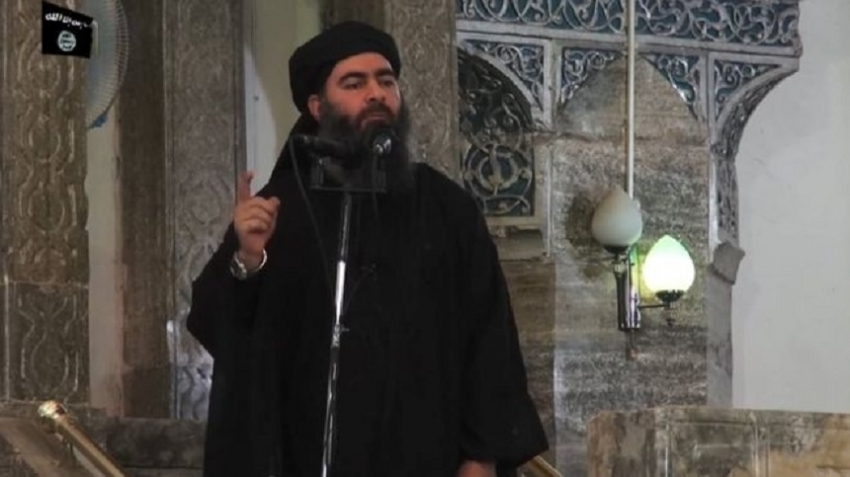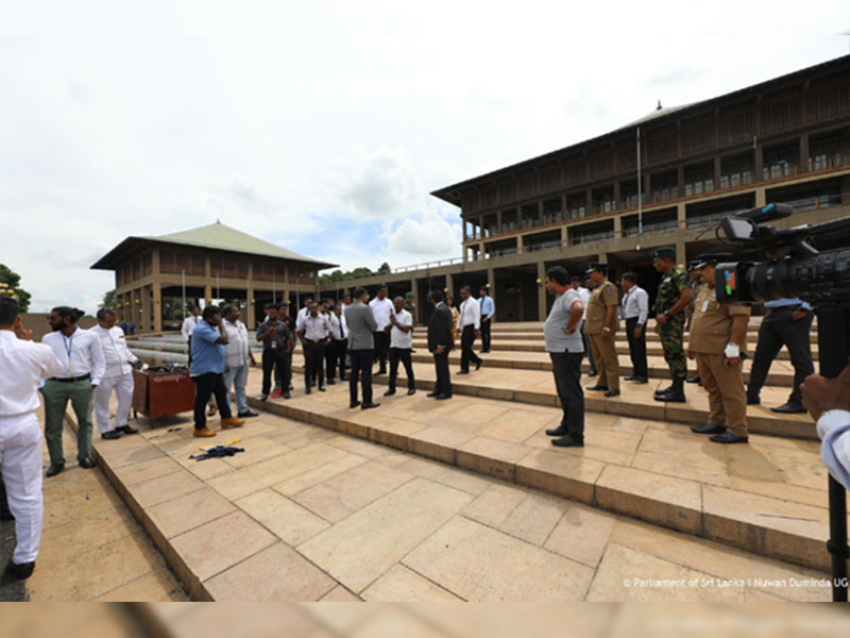(CNN)ISIS leader Abu Bakr al-Baghdadi is believed to have been killed in a raid conducted by the US military in northwest Syria on Saturday, according to a senior US defense official and a source with knowledge. The final confirmation is pending while DNA and biometric testing is conducted, both sources tell CNN.
The defense official said it appears that Baghdadi detonated a suicide vest during the raid.The raid was carried out by special operations commandos, a source familiar with the operation told CNN.The CIA assisted in locating the ISIS leader, the defense official said.Newsweek first reported that Baghdadi was believed to have been killed.
President Donald Trump is scheduled to make a major announcement Sunday at 9 a.m., White House deputy press secretary Hogan Gidley announced. An administration official tells CNN that the announcement is foreign policy related.The Pentagon did not immediately respond to a request for comment.
Baghdadi, the leader of the terror group, has been in hiding for the last five years. In April, a video was published by the ISIS media wing al-Furqan that showed a man purporting to be Baghdadi. It was the first time Baghdadi has been seen since July 2014, when he spoke at the Great Mosque in Mosul.In February 2018, several US officials said Baghdadi had been wounded in an airstrike in May 2017 and had to relinquish control of the terror group for up to five months because of his injuries.Baghdadi became the leader of Islamic State of Iraq (ISI) in 2010. In 2013, ISI declared its absorption of an al Qaeda-backed militant group in Syria and Baghdadi said that his group will now be known as Islamic State in Iraq and the Levant (ISIL or ISIS).White House officials were at the White House late Saturday evening in preparation.One official told CNN the announcement will be in the Diplomatic Reception Room.Trump stoked speculation when he tweeted Saturday evening "something very big has just happened!"
(BBC)There are unconfirmed reports of a US raid against Islamic State leader Abu Bakr al-Baghdadi The US military has conducted an operation against the fugitive leader of the Islamic State (IS) group, US media report.Claims of a raid against Abu Bakr al-Baghdadi have not been confirmed.The White House said US President Donald Trump would make a "major statement" on Sunday, but gave no further details.Mr Trump earlier shared a cryptic tweet saying: "Something very big has just happened!"Officials quoted anonymously by various media outlets said US forces targeted the militant leader in a raid in northwest Syria.
A US official told Reuters news agency an operation took place but was unable to confirm speculation that Baghdadi was killed.The IS leader has been wrongly reported to be dead on previous occasions.The White House has not confirmed either that an operation took place, or its alleged outcome.The raid was carried out by special operations forces after they received "actionable intelligence", Newsweek said, citing unnamed sources.
Following the reports, UK-based war monitor the Syrian Observatory for Human Rights said helicopter gunfire had killed nine people near a village in Syria's Idlib province, where "groups linked to the Islamic State group" were present.Mr Trump is set to make his statement at 09:00 (13:00 GMT) on Sunday.
Why is it so difficult to track down IS leader?
By Frank Gardner
Abu Bakr al-Baghdadi has not been seen on video for five years He is the world's most wanted man. Abu Bakr al-Baghdadi, the fugitive leader of the Islamic State (IS) group and its self-styled "caliph", has a $25m (£19m) US government bounty on his head.For more than three years he has been dodging capture, and ever mindful of his security, until now he has only ever appeared once in-vision, when he delivered his sermon from Mosul in 2014 declaring a "caliphate", ruled by him.Earlier this week, Baghdadi resurfaced in an 18-minute online video, rallying his supporters but, not surprisingly, giving no clues as to his current whereabouts.So where is he, how is he being searched for, and why cannot the US and its allies, with all their sophisticated technology, locate him?
Reports say that on 3 November 2016, Baghdadi made a mistake that nearly cost him his life.The battle for Iraq's second city of Mosul was getting underway and US-led coalition forces were pressing in on IS fighters.From somewhere just outside the city, Baghdadi made a 45-second radio call exhorting his followers to keep fighting. The message was intercepted by electronic eavesdropping aircraft operated by the coalition, a voice match was made and there was a frantic scramble to react.But by then the IS leader was gone, moved on by his bodyguards and no doubt implored by them not to take to the airwaves in real time ever again.
It took US intelligence almost 10 years to track down and kill Osama Bin Laden, between the day of the 9/11 attacks in 2001 until the small hours of 2 May 2011 when US Navy Seal commandos burst into his compound in Pakistan.America's National Security Agency (NSA) and Britain's GCHQ have a staggeringly large capacity for Signals Intelligence, known as 'Sigint', monitoring, intercepting and decoding both open and encrypted communications around the world.
Who is Baghdadi?In the old days, terrorists on wanted lists would sometimes give away their locations by making calls from their mobile phones or staying online too long from one location.Bin Laden was wise to that, and Baghdadi has been too - mostly.The al-Qaeda leader was eventually tracked down to his Abbottabad lair not through his digital footprint but through the courier who ferried his propaganda videos and other messages by hand from there to wherever they were being uploaded onto the internet.
Abu Bakr al-Baghdadi's last appearance was in a mosque in Mosul in 2014 Tracing this reverse journey is likely to be one of the first things US intelligence is likely to be doing in the days following Baghdadi's video release, but his security team will be wise to that.Only a very small number of trusted associates will be with him and they are likely to be moving him around constantly.
Born near Samarra, Iraq, in 1971, his real name is Ibrahim Awad al-Badri.Deeply religious from an early age, he later spent time incarcerated in the US-run internment camp of Camp Bucca in 2004 following the Anglo-US invasion and occupation. There he forged close alliances with other inmates, including former Iraqi intelligence officials."He learned a lot on how to operate from Saddam's former intelligence officials," says Michael Stephens, a Middle East expert with the London-based think-tank Royal United Services Institute (Rusi)."His operational security is excellent," he adds, "partly because of his excessive paranoia". Where is he hiding now? Almost certainly still in the Iraq-Syria border area, says Stephens."He'll be able to take advantage of established smuggling networks across that border," he says, "using money to pay his way amongst the tribes there".
Baghdadi forged alliances with former Iraqi intelligence officials during his time in a US-led prisonIraq's former strongman Saddam Hussein went on the run for nine months after his regime was overthrown.US operation Red Dawn tracked him down to an underground hiding place near his birthplace in Tikrit after a human informant betrayed his whereabouts for a multi-million dollar reward.But getting such a "mole" inside Baghdadi's inner circle would be very difficult indeed. The tiny amount of people in close proximity to him could well be so loyal as to be beyond financial temptation.So if the world's most wanted man is staying off-line, he is not making any calls on a mobile phone, and he is possibly moving around constantly from one hiding place to another, then what hope does Washington and the West have of ever finding him? (Preferably before he orchestrates or inspires the next major IS attack).Ultimately, it may well come down to luck and patience: a chance sighting by an inquisitive villager, an unusual configuration of vehicles spotted by an alert drone operator, or even an exhausted and disillusioned IS member who decides it is finally time to take the reward money on offer and spend the rest of his or her life, fabulously rich and forever in hiding.
Where is the Islamic State group still active around the world?
By Mina al-Lami
After months of fighting, the jihadist group Islamic State (IS) has finally lost Baghuz, a village in eastern Syria that came to represent the final chapter in its self-styled caliphate.While this is a major blow, the loss of the small enclave near the Iraqi border does not spell the end of IS as a militant group capable of mounting deadly attacks worldwide.IS and its affiliates continue to be active in various countries, claiming attacks on a daily basis through the group's online propaganda outlets.Data collected by BBC Monitoring shows that despite having lost most of its territory in Syria and Iraq at the end of 2017, IS said it was behind 3,670 attacks worldwide last year - an average of 11 attacks per day - and 502 attacks in the first two months of 2019, while Baghuz was under siege.There was a peak in IS attack claims in September 2018. This was likely to have been linked to the start that month of an operation by the US-backed Syrian Democratic Forces (SDF) alliance to take the IS stronghold of Hajin, north of Baghuz.
The jihadist group commonly steps up its attacks in response to offensives against it, either in the area under siege or elsewhere to divert attention or resources away from there.Although Iraq and Syria continue to account for the lion's share of IS attack claims, Afghanistan, Somalia, the Philippines, Nigeria and Egypt's Sinai peninsula also feature regularly.In a recent message, the IS leadership mocked US President Donald Trump's claim in December to have defeated the group, and insisted that it was far from over.Nevertheless, IS's caliphate model has been over since late 2017, when it lost its strongholds of Mosul in Iraq and Raqqa in Syria. After that, the group struggled to project the image of a functioning and flourishing state - which had formed the basis of its claim to have revived the caliphates of early Islam.
The data is based exclusively on what the group itself has claimed through its official "Nashir News Agency" media outlets on the messaging app Telegram. The dates reflect when IS said the attacks took place, rather than when the claim was published.The data includes every claim of attack, no matter how small or inconsequential. Most attacks that IS claimed solely through its weekly newspaper al-Naba without issuing a separate statement were not reflected in the data.
It is worth noting that IS, like any jihadist group, has a tendency to exaggerate the scale of its attacks and their impact.
IS has officially declared that it has a presence in the following countries and regions: Iraq, Syria, Libya, Egypt, Yemen, Saudi Arabia, Algeria, "Khorasan" (the Afghanistan-Pakistan region), "the Caucasus", "East Asia" (mostly active in the Philippines), Somalia, and "West Africa" (mostly active in Nigeria).Some of these branches, such as Algeria and Saudi Arabia, have barely claimed any activity, and others like "the Caucasus" rarely claim attacks.The group recently signalled through its propaganda an intention to step up its activity in Tunisia, a country where it has so far failed to make inroads following the 2015 attacks on a museum and beach resort that it claimed. IS also announced for the first time a presence in Burkina Faso.
The announcements about Tunisia and Burkina Faso suggest that at least in terms of propaganda, IS is keen to indicate that its trademark slogan "Remaining and Expanding" still applies.Unsurprisingly, IS's biggest battleground continues to be in Iraq and Syria, where it clearly has its best resources.Out of a total of 3,670 attacks IS claimed worldwide in 2018, 1,767 were in Iraq (48%) and 1,124 were in Syria (31%).
Nigeria's army has increasingly come under attack by a branch of IS in recent months
But last year also saw a notable increase in claimed activity by other IS branches. It was as if the group wanted to compensate for its losses in Iraq and Syria and to remind people that it also operated outside the Middle East.In 2018, IS claimed 316 attacks in Afghanistan, 181 in Egypt's Sinai peninsula, 73 in Somalia, 44 in Nigeria, 41 in Yemen and 27 in the Philippines.The number of attack claims by IS West Africa Province in Nigeria has notably risen in recent months. The army has been the primary target, possibly because the group is attempting to seize weaponry and in turn boost its capability.
IS has claimed 44 attacks in Nigeria in the first three months of 2019, matching the total number of attacks it claimed in a whole year in 2018.In a propaganda video released in January, IS West Africa Province called on Muslims to migrate to the region and join its branch, signalling that it was ready to receive foreign recruits.On 22 March, IS West Africa Province announced for the first time that it had a presence in Burkina Faso - a country where its rival al-Qaeda has already carried out several attacks.There has also been an uptick in the number of attack claims in the Philippines.IS operates in the country through local affiliates, most of which have been fighting to establish an independent Islamic state in the south for decades. But their attacks, mostly against the army, are still sporadic.
And despite repeated calls to its supporters, IS did not claim any major attacks in the West during 2018.The previous year, it claimed four attacks in the UK, including the Manchester Arena bombing; the Barcelona attacks in Spain; and the Las Vegas shootings in the US. However, some of those claims appeared to have been opportunistic, as the group failed to provide evidence.In 2018, IS claimed seven, mostly low-profile attacks in the West that appeared to have been inspired by the group. They comprised four knife or gun attacks in France, and one attack each in Belgium, Canada and Australia.
Who is Islamic State leader Abu Bakr al-Baghdadi?
By William McCants
Ibrahim Awwad Ibrahim al-Badri, otherwise known as Abu Bakr al-Baghdadi, was born in 1971 in Samarra, Iraq, to a lower-middle class Sunni family.His family was known for its piety and his tribe claimed descent from the Prophet Muhammad.As a youth, Baghdadi had a passion for Koranic recitation and was meticulous in his observance of religious law.His family nicknamed him "the Believer" because he would chastise his relatives for failing to live up to his stringent standards.Baghdadi pursued his religious interests at university. He obtained a bachelor's degree in Islamic studies from the University of Baghdad in 1996, and a Master's and PhD in Koranic studies from Iraq's Saddam University for Islamic Studies in 1999 and 2007 respectively.Until 2004, Baghdadi spent his graduate school years living in the Tobchi neighbourhood of Baghdad with his two wives and six children.
He taught Koranic recitation to neighbourhood children at the local mosque, where he was also the star of its football club.During Baghdadi's time in graduate school, his uncle persuaded him to join the Muslim Brotherhood.Baghdadi quickly gravitated towards the few violent ultra-conservatives in the Islamist movement and by 2000, under their tutelage, had embraced Salafist jihadism.
Within months of the 2003 US-led invasion of Iraq, Baghdadi helped found the insurgent group Jaysh Ahl al-Sunnah wa al-Jamaah (Army of the People of the Sunnah and Communal Solidarity).In February 2004, US forces arrested Baghdadi in Falluja and sent him to a detention facility at Camp Bucca, where he remained for 10 months.While in detention, Baghdadi devoted himself to religious matters, leading prayers, preaching Friday sermons, and conducting classes for prisoners.The US held Baghdadi at a detention centre in Iraq for 10 monthsAccording to a fellow inmate, Baghdadi was taciturn but had a knack for moving between the rival factions at the facility, where former Saddam loyalists and jihadists mingled.Baghdadi frmed alliances with many of them and stayed in touch when he was freed in December 2004.After his release, Baghdadi contacted a spokesman for al-Qaeda in Iraq (AQI), a local al-Qaeda affiliate run by the Jordanian Abu Musab al-Zarqawi.
Impressed with Baghdadi's religious scholarship, the spokesman convinced Baghdadi to go to Damascus, where he was to ensure AQI's propaganda adhered to the principles of ultra-conservative Islam.Zarqawi was killed in June 2006 by a US air strike and was succeeded by an Egyptian, Abu Ayyub al-Masri.That October, Masri dissolved AQI and founded the Islamic State in Iraq (ISI). The group continued to privately pledge allegiance to al-Qaeda.
The new emir Because of Baghdadi's religious credentials and his ability to bridge the divide between the foreigners who founded ISI and the local Iraqis who later joined the group, Baghdadi steadily rose through the ranks.He was appointed supervisor of the Sharia Committee and named to the 11-member Shura Council that advised ISI's emir, Abu Omar al-Baghdadi.
Baghdadi exploited the chaos in Syria to gain a foothold there for Islamic StateBaghdadi was later appointed to ISI's Co-ordination Committee, which oversaw communication with the group's commanders in Iraq.After the deaths of ISI's founder and its emir in April 2010, the Shura Council chose Abu Bakr al-Baghdadi to be the new emir.Baghdadi set about rebuilding the organisation, which had been decimated by US special operations forces.Hoping to capitalise on growing unrest in Syria in 2011, Baghdadi ordered one of his Syrian operatives to establish a secret branch of ISI in the country, later known as al-Nusra Front.
Baghdadi soon fell out with the leader of al-Nusra, Abu Mohammed al-Julani, who wanted to collaborate with the mainstream Sunni rebels fighting Syria's President Bashar al-Assad.But Baghdadi wanted to establish his own state through brute force before going after Assad.In the spring of 2013, Baghdadi announced that al-Nusra was part of ISI, which he renamed "Islamic State in Iraq and al-Sham/the Levant" (Isis/Isil).
So-called Islamic State was formed in defiance of the al-Qaeda leadership When al-Qaeda's leader Ayman al-Zawahiri ordered Baghdadi to grant al-Nusra its independence, Baghdadi refused. In February 2014, Zawahiri expelled Isis from al-Qaeda. Isis responded by fighting al-Nusra and consolidating its hold on eastern Syria, where Baghdadi imposed harsh religious laws. Its stronghold secure, Baghdadi ordered his men to expand into western Iraq.
The caliphIn June 2014, Isis captured Iraqi's second largest city, Mosul, and soon after, the group's spokesman proclaimed the return of the caliphate, renaming Isis "Islamic State".Days later, Baghdadi delivered a Friday sermon in Mosul and declared himself caliph.The media has wrongly reported Baghdadi's demise several times.But if he dies, the organisation will lose a skilled mediator, a ruthless politician, a religious scholar, and a man of noble lineage - an unusual combination for the leader of a global militant organisation, much less a proto-state.




















